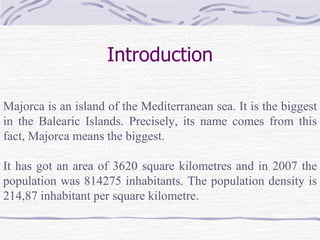
P point majorca
- 1. Introduction Majorca is an island of the Mediterranean sea. It is the biggest in the Balearic Islands. Precisely, its name comes from this fact, Majorca means the biggest. It has got an area of 3620 square kilometres and in 2007 the population was 814275 inhabitants. The population density is 214,87 inhabitant per square kilometre.
- 3. Municipalities Majorca has got 53 municipalities. The most important is Palma, capital of Majorca, followed by Manacor, Inca, Llucmajor and Calvià. We can also point out Pollença and Sóller for its history. The biggest are Llucmajor, Manacor, Palma and Felanitx. The smallest are Buger, Lloseta, Estellencs and Consell
- 4. Orography There are three different areas: the range of Tramuntana, the range of Llevant and the central depression
- 5. Orography The range of Tramuntana is 90 km long. There we can find the tallest mountains in Majorca: the Puig Major (1445m), the Massanella (1340m), the Ofre (1090m), the “Es Teix”(1064m), and the Galatzó (1026m). The coasts of the range make breathtaking cliffs which in some places reach 400 metres. Puig Major- the tallest mountain in Majorca
- 6. Climate Majorca has got a mediterranean climate. This climate is mild. Its main characteristics are the following: dry summers, showers are concentrated in autumn and spring. The average temperature is 17ºC.
- 7. Vegetation Majorca’s vegetation is related to the following: climate (species are conditioned), the fact of being four islands (the process of evolution is different and it gives way to autoctonous species) and human being. Main vegetation is pine wood, holm, oak wood and scrubs.
- 8. Economy For many centuries the economy of the island was based on agriculture and cattle raising. Industry has developed mainly in Palma, Manacor (furniture and pearls) and the villages which form the Raiguer region (leather and glass industry). From the sixties onwards tourism has been the motor of the island and is also responsible for demography, social, economic and enviromental changes which have taken place.
- 9. Majorca: area and inhabitants Mallorca is made up of 53 municipalities. The archipielago of Cabrera belongs to the municipality of Palma. Regions: A region is made up of some municipalities which share some physical, enviromental and economic features.
- 10. Region of “Es Pla” The Region of “Es Pla”- It is formed by municipalities situated in the centre of the island and the bay of Alcudia. Palma is a region itself together with the Archipielago of Cabrera.
- 11. Region of Migjorn- Llevant The region of Migjorn- Llevant is made up of southern and eastern coastal municipalities.
- 12. Region of Tramuntana The region of Tramuntana is made up of municipalities situated in the range of mountains in the north of the island.
- 13. Region of “es Raiguer The region of “es Raiguer” is formed by municipalities located between the Tramuntana range of mountains and the region of “es Pla”.
- 14. The migratory movement The first migration waves to arrive in the Balearics were in late seventies. They came from the Spanish provinces. However, at present migration comes from the European countries, Africa, Central and South America. Migration is very enriching for destination countries because it contributes to a new and different social life and traditions. Also, it makes for the economic development. On the other hand, the destination country should provide with health system, schooling and social security.
- 15. Festivals- Christmas The first Christmas celebration is midnight mass on the 24th December. The most important moment is the Sibil.la’s song, a prophetic song from the Middle Age. Christmas Day and Sant Esteve’s Day (Boxing Day) are reservated for lunch with the family.
- 16. Festivals- Sant Antoni The festival starts on the evening of the 16th January when many bonfires are lighted. People gather around the bonfires scattered in the village and grill “sobrassada”, other typical sausages and pork meat . This constitutes their supper together with wine. Devils dance around the bonfires and typical songs “glosses” are sung. On the 17th parades take place. The floats are mostly scenes from rural areas, and devils. Pets are taken to church to be blessed.
- 17. Festivals- Sant Antoni The festivity of Sant Sant Antoni Abad takes place on the 17th January. It is mostly celebrated in the villages. The most well-known festivals are those in Sa Pobla, Artà, Pollença , Muro i Manacor.
- 18. Festivals- The Moor and the Christian On the 2nd August, day of the “Mare de Déu dels Àngels”, the saint patron of Pollença. We commemorate the victory of the Christian on the Moor Dragut, who on the night of 30th May 1550 attacked the village of Pollença. The legend tells that Joan Mas (Christian) invocated the “Mare de Déu dels Àngels” and she helped them to beat a much better army made up of 1500 men
- 19. Festivals- The Moor and the Christian The celebration starts the night before, with a big party in the streets and squares of Pollença and lasts until the morning of day two, when at five in the morning, the music band starts to play music along the streets. Each year the inhabitants of Pollença act out what happened during the Christian-Moor battle. The main roles documented go back to 1860 and are chosen by popular voting the first week of July.
- 20. The Moor and the Christian- Pollença
- 21. Festivals- La Beateta The Beata festival takes place in Santa Margalida the first weekend of September. It is the most typical parade in Majorca. Its origin still remains unknown. The Beata festival is also celebrated in Valldemossa on the 28th July. In the parade there is always a Valldemossa born six year old girl and three three year old angels followed by people singing “la Beateta” (a popular song).